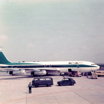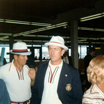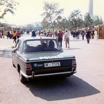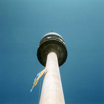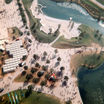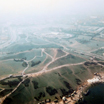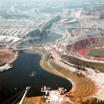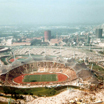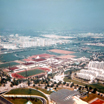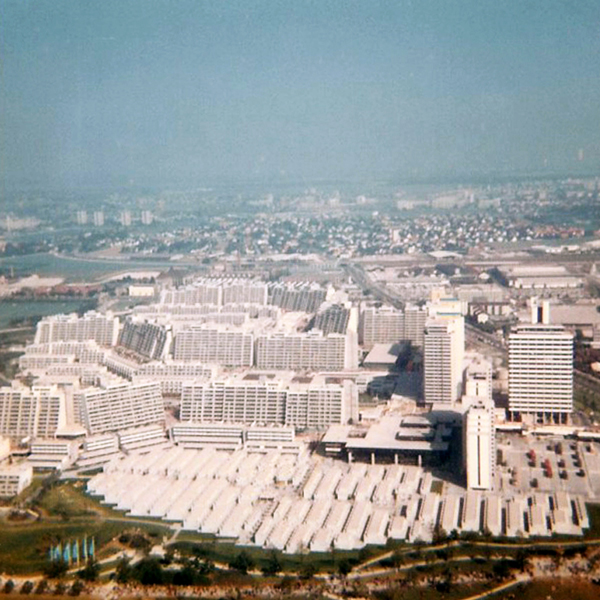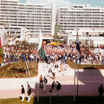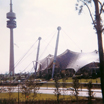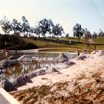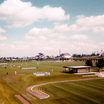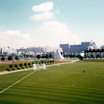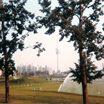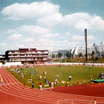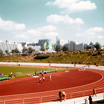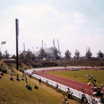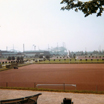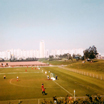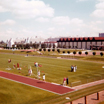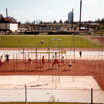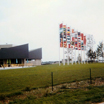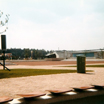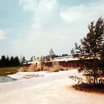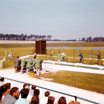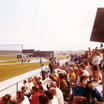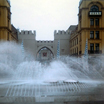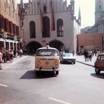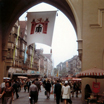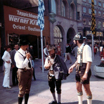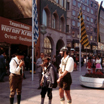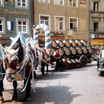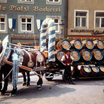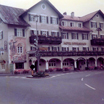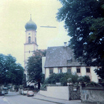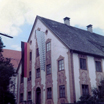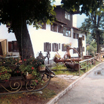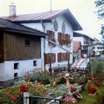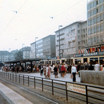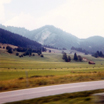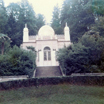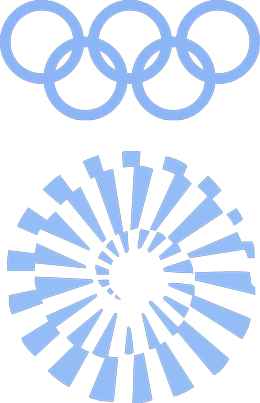
How We Got The Gold In Munich
American riflemen came home with four medals and three world records; here's how it looked behind the firing line
By NRA Staff
U.S. rifleman lived up to the highest standards of traditional American marksmanship in the XX Olympiad by winning four medals and setting three new world records in prestige events.
The fine showing gave the U.S. rifle competitors two Gold medals and two Silvers out of a total of 24 medals awarded for shooting, and contributed to a record-breaking spree in which rivals from around the world smashed 40 records in a variety of sports. Like the Americans, the Russians won four shooting medals: One Gold, two Silvers, one Bronze. Italy, East Germany and Romania took two medals each. The other 10 went to 10 other countries in matches which were conceded to be "the best-run shooting events ever."
Army Reserve Lt. John H. Writer of Clarendon Hills, Ill., led the riflemen by capturing a Gold Medal and setting a new world record of 1156 in small bore rifle three-position shooting, along with a world record 381 in the standing stage. Army Capt. Lanny R. Bassham made it to a one-two U.S. sweep in that event by firing 1157 for the Silver.
The second Gold was taken by Army Maj. Lones W. Wigger, Jr., who defeated Russia's Boris Melnik by tie-breaking rules after both scored 1155 in the 300-meter free-rifle contest. Wigger's 379 standing set a world record.
The fourth U.S. medal went to Victor L. Auer of North Hollywood, Calif., whose 598 prone score in the English Match earned him a Silver medal.
Gold Medalist Writer, 28, had an eye on his victory almost since he started shooting at age 12. He took the Silver in three-position at Mexico City four years ago. He is known for both speed and accuracy and the word went out: Writer is the man to watch. Competitors and spectators alike conceded the Gold to Writer and felt the real contest was for Silver and Bronze.
Writer, not a prone shooter, was 14th at the end of the prone phase. His 395, however, was the highest among the medalists. In the grueling standing position Writer showed his mettle. No one believes it is possible to capture an international Gold without controlling the second stage. Writer shot strings of 95-98-94-94 for a new world standing record of 381 and an 11-point lead over the four closest contenders. There was no catching him, and he shot 390 kneeling to take the Gold with a nine-point margin and set World and Olympic records in the course.
Meanwhile, Bassham and three others were deadlocked after the standing stage at 765. Also a speedy shooter, Bassham had a poor 390 total in prone. He slowed a bit to fire a solid 375 standing, second only to Writer. He finished with 392 kneeling, for the Silver. Realizing the odds against such a sweep, team captain Walter Walsh said only "How sweet it is!"
Writer said he was careful in the prone match. "I generally shoot the prone in 25-30 minutes," he said. "I slowed it down to 35-40 minutes for this contest." Writer, who visits with spectators and signs autographs when not on the line, explained why he hadn't touched his rifle until some shooters had shot half their prone strings: "I take some time to pull myself together, to get the concentration back. I want complete control before each phase."
He added that in the U.S. there are no uniform training methods, so each individual trains and competes at his own rate.
Wigger's Gold in 300-meter free-rifle along with his small bore win in the 1964 Olympics, gave him a "double" - Gold in both small bore three-position and free-rifle - a feat matched only once in Olympic shooting, by a Russian, Anatoli Bogdanov, in 1952 and 1956 (U.S. champion Gary Anderson won both 300-meter and small bore Gold Medals in the World Shooting Championships in 1962 and again in 1966).
The 300-meter contest was full of drama, suspense and excitement. Wigger began by firing 394 prone for a tie for fourth. But then he confirmed the view that top shooting in offhand is necessary for a victory in any three-position aggregate when he posted a new world record of 379 standing and jumped to a five-point margin over Russian Boris Melnik.
After the 1964 Olympics, Wigger told a reporter "I feel the standing position is the hardest and wins most matches." He practices more in standing than other positions, and this year his perseverance paid off in Gold.
Just when Wigger seemed well on his way to challenging the world record of 1157, he ran into gun trouble. He posted a pair of 95's in the opening strings of the kneeling stage, then had to pull a gun repair job on the line.
"The glass bedding just gave away. I took the thing apart and wedged a couple of shims in between the barrel and stock," he recounted later.
Wigger, back on the line with the faulty rifle, had to settle for another 95 and a 97 for a somewhat disappointing 382.
The unofficial score listed Melnik with 1155 and Wigger with 1154. The dejected Wigger was sure he had lost; but a hppay surprise was due. The targets of the top 10 competitors are automatically rescored and Wigger gained a point kneeling in the rescoring, pushing the match into a tie. Tie-breaking measures award the entire match to the individual posting the best score for the final kneeling string. Wigger's win came from the 97 on his last 10 kneeling shots, one point better than Melnik's string. When the win was officially confirmed, all the happy Wigger could say was, "I was lucky."
Bassham had ended the prone with only 389, well back in the pack. He worked his way up with 368 standing and 387 kneeling for a total of 1144 and seventh place.
The remaining U.S. medalist, civilian Vic Auer, took the Silver in that most unpredictable of rifle contests, the English Match, 60 shots prone at 50 meters. Auer, troubled only in the second string where he posted 98, put together five perfect 100's for a 598 total, tying the world record. There was one more 598 posted, by Nicolae Rotaru of Romania; but Rotaru had 99 on his final string, and the victory looked solidly Auer's.
But where the rescoring of the top 10 shooters' targets gained the victory for Wigger in free-rifle, it lost the Gold for Auer. Ho Jun Li, an unknown foot soldier from North Korea, was down in a cluster of shooters unofficially scored at 596; but he picked up three points in the rescoring to turn his 596 into a 599 for the Gold and a new world record.
After Li's official victory was posted, he told reporters, "I thought I was shooting at my enemies. Our prime minister, Kim II Sung, told us prior to our departure to shoot as if we were fighting our enemies. And that's exactly what I did."
Later, in a hastily-called press conference, Li said he had been misquoted. "I never said that; it must have been a misunderstanding."
Wigger, the other U.S. shooter entered in the English Match, finished seventh with a respectable 597.
In the other events, American shooters did not finish among the medalists, but all made respectable showings. In clay pigeon, Air Force Lt. James Poindexter came in sixth with 192; Army Sgt. Don Haldeman, fighting the flu, came up with 187, including a perfect 50 birds the last day, for 17th clay pigeon place. In skeet, Jack Johnson was ninth with 192, while Tony Rosetti came in 34th with 186.
The best U.S. showing with the pistol was that by Army SFC James McNally, who was 10th in rapid-fire pistol with 589. Marine Lt. Col. William McMillan scored a miss in a four-second string by firing his last shot just before the target turned, and came in 45th with 572. The free-pistol shooters, Marine Reserve Gy/Sgt. Jimmie Dorsey and Army SFC Hershel Anderson, came in 28th and 34th with 544 and 540 respectively. Army SFC Edmund Moeller showed up in ninth place in the running boar shoot with 550, while SFC Charles Davis was 19th with 540.
There are several reasons why the pistol and moving target shooters weren't on top, in the opinion of experts, but American reluctance to accept International shooting styles is the big one. Foreign handgunners have to excel in only one type of pistol shooting. Most even specialize in one gun, while U.S. pistol shooters shoot three guns in conventional American style and three of four more in International shooting. American shotgunners shoot the less demanding domestic style for the U.S. season and then compete against the world's best shotgunners under different rules. The difference is not so pronounced in rifle shooting, so by concentrating on the more difficult International style our shooters can actually enhance their performances in our own matches.
American Rifleman, Vol. 120 No. 11, November1972
Munich, A Victory For U.S. Shooters
Editorial
Amid all the sorry turmoil and tragedy of the XX Olympiad, shooters on the U.S. Olympic squad carried out their role as sportsmen with flying colors - the colors being the Stars and Stripes, which were run up for two Gold Medal wins and two Silver Medal awards, the best record of its kind for any of the competing countries.
The four riflemen representing the United States turned in one of the finest performances of any comparably small group of athletes and competitors in the entire sports spectacular. In doing so, they smashed three of the 40 world records in all sports that fell at Munich.
The matches at Munich were run with Teutonic thoroughness on ranges and in structures that were magnificently suited to the purpose. The vital function of scoring was carried out with equal impressiveness. To stimulate spectator interest - and there was plenty of it - a record keeper behind each shooter called out the value of every shot as he saw through a spotting scope. Those calls, however, were not official. In two instances, at least, they led shooters and spectators alike to wrong conclusions as to winners.
The actual scoring was done so coldly and methodically, later, that no one involved knew the identity of the shooter whose target he scored. Small bore targets were machine-read on close calls, and every tight pistol and 300-meter rifle target was juried. The system insured that every shooter got his due. As every bullet hole is a known distance from center, the prickly problem of judgment calls did not enter into it as it necessarily did in some other sports.
To all involved, of whatever nationality, The National Rifle Association of American, which represents Olympic shooting, tenders a salute and a "Well done!"
American Rifleman, Vol. 120, No. 11, November 1972
U.S. Shooting Team
Rifle Members
Victor L. Auer, Lanny R. Bassham, Lones W. Wigger and John H. Writer
Pistol Members
Hershel L. Anderson, Jimmie R. Dorsey, William W. McMillan and James H. McNally
Trap Members
Donald S. Haldeman and James C. Poindexter
Skeet Members
Jack E. Johnson and Anthony Rosetti
Running Boar Members
Charles D. Davis and Edmund O. Moeller
Team Management & Support
Walter R. Walsh (Head Manager), Harry Reeves (Assistant Manager) and James Carter (Armorer)
U.S. Olympic pistol squadding finished
Marine Lt. Col. William McMillan, Turtle Creek, Penn., and Army SFC James McNally, Columbus, Ga., completed the four-member U.S. pistol delegation to the Munich Olympics by capturing first and second places, respectively, in rapid-fire pistol tryouts yesterday.
McMillan, a gold-medal winner in the 1960 Olympics at Rome, is officer in charge of the Marine Corps shooting team, McNally is a shooter on the Army's Marksmanship Training Unit at Ft. Benning, Ga., McMillan finished with 1,753 out of a possible 1,800 while McNally had 1,752.
A dispute over second in the running-board event was resolved by a recheck of Monday's targets, and the Olympic team berth went to SFC. Edmund O. Moeller, Moulton, Tex., who finished with a 1,625, one point up on Air Force M/Sgt. Robert Dickens, Lackland Air Force Base, Tex. Moeller joins SFC. Charles D. Davis, a fellow Ft. Benning shooter from Hazard, Ky., who won with 1,649.
After two days of three scheduled for three-position small bore, Army Reserve 1st Lt. John Writer, Claredon Hills, Ill., was leader with 2,317 out of a possible 2,400. Another Army Reservist, Capt. Margaret Murdock, Topeka, Kan., and Marine CWO3 David I. Boyd, Quantico, Va., were deadlocked behind Writer with 2,305's. Holding fourth was Army Capt. Lanny Bassham, Ft. Worth, Tex., with 2,300, and in fifth was Army Maj. Lones Wigger, Carter, Mont., with 2,281.
A non-Olympic variation of running boar, mixed runs, was won by Air Force M/Sgt. Robert Yeager, Bradford, Penn., after he and Dickens finished in a tie with 360's.
The Olympic squad after yesterday's shooting thus contained 10 members with four more to be chosen - the top two in 3-position small-bore (ends today) and the top two in free rifle (ends Sunday).
The Squad so far:
SHOTGUN: Anthony Rosetti, Jr., Biloxi, Miss., and Jack Johnson, San Antonio, Tex. (skeet); 2nd Lt. James Poindexter, Air Force, Brandbury, Calif., and Sgt. Donald Haldeman, Army, Souderton, Penn. (trap).
PISTOL: SFC Hershel Anderson, Army, Tracy City, Tenn., and GySgt. Jimmie R. Dorsey, Marine Reserves, Spokane, Wash. (free pistol); Lt. Col. William McMillan, Marines, Turtle Creek, Penn., and SFC James McNally, Army, Columbus, Ga. (rapid-fire pistol).
RUNNING BOAR, SFC Charles D. Davis, Army, Hazard, Ky., and SFC Edmond O. Moeller, Army, Moulton, Tex.
Arizona Republic, June 21, 1972
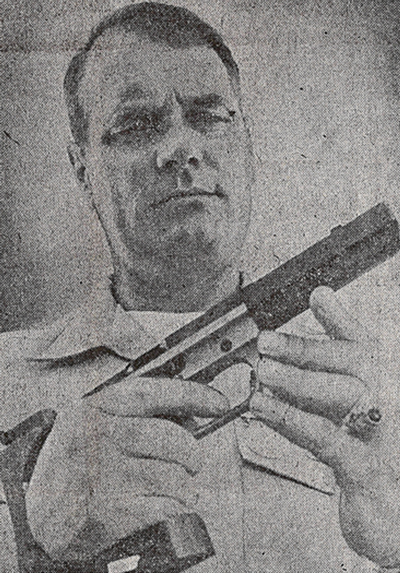
Area Marine Aims For Olympics
PHOENIX - IN his early 40's, Bill McMillan isn't the old man of the U.S. Olympic Shooting Team, but he's the most Olympics-exposed.
The XX Olympiad at Munich is his fifth in a once-broken string dating back to 1952. No other American shooter comes even close to this record - and probably not many Olympians in any sport.
A career Marine, the Turtle Creek (Pa.) native has risen to lieutenant-colonel in a 25-year career. He came out of Turtle Creek High School in 1946, a classmate of football star (Norte Dame, NFL) Leon Hart.
He now heads the weapons training battalion at the key Marine base at Quantico, Va. and is captain for the Marine Corps shooting team.
In the Olympics, the McMillan peak was a gold medal (first) in rapid-fire pistol at Rome in 1960. He also won a gold medal in center-fire pistol in the World Shooting Championships - bigger by far for shooters than the Olympics - at Moscow in 1958.
He qualified for this year's Olympiad by racking up his 11th U.S. rapid-fire championship - and it was something extra for McMillan to reach the '72 team.
"This is very likely my last chance to shoot in the Olympics," he said afterward. "I wanted this much more than I have other times."
He shot for the United States on Olympic teams in 1952, 1960, 1964 and 1968.
McMillan became a pistol champion by chance. As a young enlisted Marine at a major East Coast Navy yard range, he was assigned a brass-policing detail - picking up spent cartridge cases.
His sergeant, putting together a shooting team, needed another pistol entrant. He urged McMillan to try. The big Pennsylvanian declined - at first.
"Well," the sergeant put it, "you have a choice. You can start pistol shooting, or you can spend the rest of your tour here polishing brass."
McMillan abruptly became a pistol shooter, and the United States and his branch of service have prospered many times since.
He is also an accomplished rifleman. He fired in 1971 with the Marine rifle team in the National Matches at Camp Perry, and he has won the Marine Corps rifle crown two times.
More particular for a Marine, he has won the combined rifle-pistol title five times. This is a championship about which few "outside" competitors are aware, but it's one which generates extensive pride within the Corps.
Married and now living on the base at Quantico, McMillan is the father of three children.
The Pittsburgh Press, Sunday, July 2, 1972
10 Navy, Corps Athletes On U.S. Olympic Team
MUNICH — Forty-eight servicemen and one servicewoman are here as members of the U.S. team that will compete in the 20th Modern Olympiad.
The athletes break down by service as follows: Navy 5, Marine Corps 5, Army 32 and Air Force 8.
Two of the Navy men are Reservists, as is one of the Marines. There also is one civilian employee of the Navy on the team.
In addition to the 49 competitors, 12 military and civilian employees of the defense establishment were selected by the U.S. Olympic Committee to fill overhead positions as coaches, managers, etc.
These break down by service as Navy 1, Marine Corps 2, Army 7, Air Force 2.
Although the strength of the U.S. armed forces is considerably less in 1972 than 1968; only one more military athlete made the U.S. team for the Mexico City Olympics than did this year.
The list of Sea Service Olympians includes:
Boxing — Cpl. Reginald Jones, USMC, Camp Lejeune, N.C. (155 pounds); SSgt. Ray Russell, USMC, Camp Lejeune (178); Quartermaster Third Duane Bobick, USN, Naval Station, Norfolk (heavyweight).
Fencing — First Lt. Joseph Freeman, USMC, Quantico, Va. (foil); Seaman John Nonna, USNR, Naval Station, Brooklyn, N.Y. (epee).
Sailing — Ens. Robert T. E. Lansing, USNR, Naval Investigative Service Office, Chicago (first alternate).
Soccer — Lt. (jg) Walter E. Bahr, USN, Naval Air Station, Lakehurst, N.J.
Shooting — Lt. Col. William W. McMillan, USMC, Quantico (rapid-fire pistol); GySgt. Jimmie Dorsey, USMCR, Quantico (free pistol).
Track — Lt. James Dare, USN, NROTC, Stanford, Calif. (3000-meter steeplechase).
Navy Timees, September 6, 1972
MARINE MARKSMAN FIVE TIMES AN OLYMPIAN
J. Walter Thompson Company
Taking careful aim, Lt. Col. William McMillan squeezed the trigger of his pistol and a clay decoy shattered almost instantly.
Watching him, the burr-headed Marine Corps officer candidates applauded with amazement, even though the target was less than 50 feet away. Col. McMillan had stood with his back to the clay decoy and fired over his shoulder, aiming by the reflection of the target in his diamond ring.
Col. McMillan doesn't miss that shot very often, and he doesn't miss going to the Olympic Games very often either. Since he first participated in the 1952 Olympics at Helsinki, the Marine officer has shot for the U.S. team in Rome, Tokyo, Mexico City and again at the recently concluded games in Munich.
At the 1960 Rome Olympic Games, he won the coveted gold medal. This year, Col. McMillan's specialty was the .22 caliber pistol rapid fire. In this contest, five targets, 25 meters away from the marksman, are turned toward him at his signal. During the first series of volleys, he has eight seconds to fire five shots, one at each target.
On the second series, his time limit is cut to six seconds. On the third and final round, the marksman must hit all five targets in four seconds.
"Taking reaction time and other factors into consideration," he says, "that gives the marksman about 3/10's of a second to aim at each target. You don't even have time to get nervous."
The pistol he used in Munich was a .22 caliber Hammerli, made in Switzerland. Designed strictly for accuracy and meeting Olympic specifications, it shoots a small cartridge so there is less recoil. This helps the shooter hold his sights on target. Recoil is also reduced by small holes in the top of the barrel, giving expanded gases another means of escape.
An orthopedic grip is used and is custom made for most marksmen, allowing them to wear the pistol almost like an extension of the hand. A pistol such as this usually costs about $300.
Col. McMillan, who enlisted in the Corps. in 1946, never fired a pistol until 1949. At that time, he was a corporal stationed at the Brooklyn Naval Yard. From his new Marine Corps experience, he found that he like target shooting in regulated competition.
Moreover, he was good. Within three years, Col. McMillan was on the U.S. Olympic team.
He made a career out of the Corps and a lifetime avocation out of target shooting. While a staff sergeant in Korea, Col. McMillan received an officer's commission. Many people have found either their profession or avocation in the Marine Corps. The Corps has many programs designed to help people find their interests and learn new skills. Local Marine recruiters can provide more information.
By 1957, Col. McMillan was the National Champion and World Champion in 1958 and 1960. A decade later, he was still ranked third in worldwide competition.
"It's a good sport," he says, "filled with a lot of good people. The serious competitor has great powers of concentration and is not likely to get emotional with a pistol in his hands."
The 43-year-old Colonel, who was born in Turtle Creek, Pennsylvania [correction: Frostburg, Maryland], has hunted wild pigs in Arizona with a pistol. He now hunts deer with a rifle near Quantico, Va., his present duty station where he is the Commanding Officer of the Weapons Training Battalion.
He and his wife, Mary, have three children and often go together to marksmanship competitions. For variety, Col. McMillan has taken up another sport: firing the old-fashioned "ball-and-cap" rifles, similar to those used by other legendary sharpshooters like Davey Crocket and Kit Carson.
Date and Venue
The Olympic shooting competitions will be held at the Shooting Range, Hochbrück, from 27th August to 2nd Septemer, 1972
Rapid Fire Pistol: 1st Stage August 31, 1972 from 0900 — 1400 hours
Rapid Fire Pistol: 2nd Stage September 1, 1972 from 0900 — 1400 hours
Competition Rules 3.2.1 Rapid Fire Pistol
At a distance of 25 metres, ten-ring silhouettes will be set up in groups of five, 0.75 metres apart, from centre to centre.
The competition will be held in two stages, each of 30 shots. Each stage consists of six five-shot series, of which two last eight seconds each, two six seconds and two four seconds.
The shooter may fire a series of five sighting shots at eight, six and four seconds before the start of each stage.
| Place | Name | Country | 8-sec Points |
6-sec Points |
4-sec Points |
Total Points |
|---|---|---|---|---|---|---|
| 1st | Józef Zapedzki | Poland | 200 | 199 | 196 | 595 |
| 2nd | Ladislav Falta | Czechoslovakia | 200 | 197 | 197 | 594 |
| 3rd | Victor Torshin | USSR | 199 | 197 | 197 | 593 |
| 4th | Paul Buser | Switzerland | 198 | 197 | 197 | 592 |
| 5th | Jaime Gonzalez | Spain | 196 | 200 | 196 | 592 |
| 6th | Giovanni Liverzani | Italy | 199 | 197 | 195 | 591 |
| 7th | Dentcho Denev | Bulgaria | 198 | 196 | 196 | 590 |
| 8th | Gerhard Petritsch | Austria | 198 | 196 | 196 | 590 |
| 9th | Vladimir Hurt | Czechoslovakia | 200 | 198 | 192 | 590 |
| 10th | James H. McNally | USA | 195 | 198 | 196 | 589 |
| 11th | Helmut Seeger | West Germany | 198 | 197 | 194 | 589 |
| 12th | Dan Iuga | Romania | 198 | 196 | 195 | 589 |
| 45th | William W. McMillan | USA | 199 | 195 | 178 | 572 |
Source: U.S. Olympic Committee Quadrennial Report
| Place | Name | Country | Total Points |
|---|---|---|---|
| 1st | Ragnar Skanaker | Sweden | 567 |
| 2nd | Dan Iuga | Romania | 562 |
| 3rd | Rudolf Dollinger | Austria | 560 |
| 28th | Jimmie R. Dorsey | USA | 544 |
| 34th | Herchel Anderson | USA | 540 |
Source: U.S. Olympic Committee Quadrennial Report






